Table of Contents
All dogs of all breeds, of all ages, NEED obedience training! A well-trained dog is more secure, more relaxed, and happier. Dog Training establishes a great relationship between you and your dog. It also helps to keep your dog safe –they can avoid running out into dangerous situations like traffic if they can be taught to “sit” and “stay”.
A mature, trained dog is less likely to jump on guests, bark incessantly or chew things they shouldn’t at home. Training goes a long way toward improving socialization, too: dogs learn to be calm around other pets and people. In other words, with even basic obedience, all our lives are so much easier, and more fun!
Benefits of Obedience Training:
- Safety: Commands like “come” or “stay” can help protect your dog from danger (e.g. while crossing a street).
- Calmer Home: An obedience-trained dog is welcomed inside and becomes a pleasure indoors, eliminating problem behavior (jumping, barking, chewing).
- Social Skills: A well-trained dog is a polite and well-behaved one when around people – or even friendly other animals – in public or in your home.
- Strong Bond: Training acts as communication, building a bond of trust and understanding between a dog and its owner.
Training teaches dogs of any breed or age—whether puppy, adult, or senior—what we want from them. Even older dogs can learn new commands with time and patience. In fact, it’s never too late to train a dog; though puppies pick up habits quickly, adult dogs can learn just as well if you are consistent and patient.
When and How to Start Training
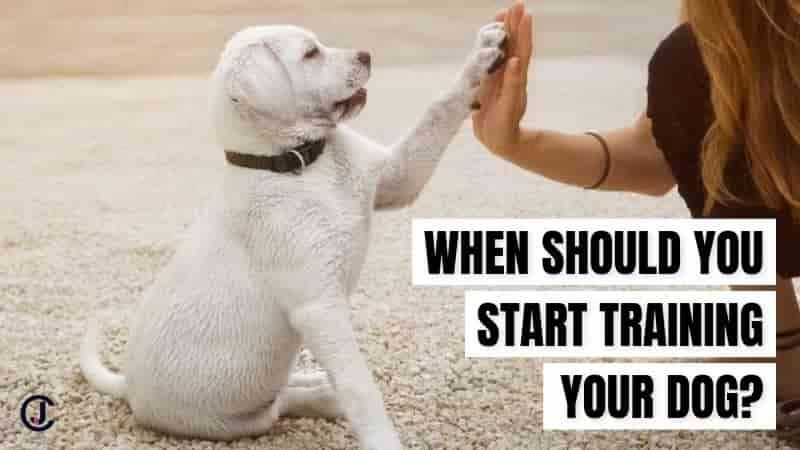
Puppies
Training should start from day one, that is, once you bring your puppy home (usually at around 8 weeks old). Young puppies can start the process of mastering basic commands (“sit,” “stay,” “come”) immediately. The most receptive time for learning is somewhere between around 6–16 weeks when puppies are very keen to please.
During this period, make the sessions short and fun, just a few minutes at a time a few times a day. Dogs have short attention spans so 5–10 minutes per session is plenty. Always leave them with a positive so they are looking forward to their next session.
Start with positive reinforcement: Reward your puppy right away when they get things right (treats, praise, play). Avoid any harsh corrections. According to PetMD, the only training technique with scientific backing is positive reinforcement, and punishment (such as shock or choke collars) should be avoided entirely. Ignoring a puppy will make him anxious, as will any harsh methods, so simply reward positive behaviors.
Adult Dogs
Old dogs can’t learn new tricks That old adage is a myth, too, but the short answer simply: no, it’s not too late to train a dog. You can teach an old rescue dog new tricks – and with patience and a gentle approach, you can set your new friend on the road to lifelong good behavior. If you missed out on early puppy training, you’ll simply go more slowly: You’ll break commands down into tiny parts, use very high-value rewards, and rebuild trust.
Potty training an adult dog or socializing one that missed out on puppy socialization also takes patience and a set routine. All the same basics apply: short sessions, rewarding through a reward, and clear cues. Adults need training, also, for safety and manners.
Also Read: How to Potty Train Your Dog at Home!
General Tips for Starting Basic Obedience Training for Dogs
- Short and sweet: Better to break it up with several 5–10 minute mini-lessons each day, rather than cram into one long session.
- Consistency: Use the same cue words and cues every time. If, for example, you say “sit,” make sure you always want the same down position and use the same hand signal.
- Positive tone: Make the training fun and upbeat. Saying “Great dog!” or some other positive praise with good-voice. and treats. More training: Dogs learn best when training feels like play, not punishment.
- Training: Reinforce commands as part of day to day life: e.g., a “sit” before meals, etc. This is an aid to instruction and trains dogs to obey at all times.
- Patience: Puppies and new dogs sometimes mess up. They are like little kids in the process of learning how to follow rules. That is normal! Don’t let it frustrate you, but instead, very calmly start over with an easier step. Every little victory is a step toward something better.
Training is something you and your dog should both enjoy. Kept a happy attitude, used a play tone,peaky tone we call it,,don’t let your dog see any frustration, Keep it happy! Be aware that learning is gradual. The trick is to practice regularly and offer lots of praise.
Positive Reinforcement and Corrections
Training by positive reinforcement is the best method. The idea is to reward the dog with anything he wants: a treat, a toy, or praise for good behavior. For example: if the dog sits on command, give it a treat right away and say “Good sit!” so that the dog associates the reward with the command. Along with studies, such training techniques have found that rewards lead to trust and cooperation, while punishments result in fear or anxiety.
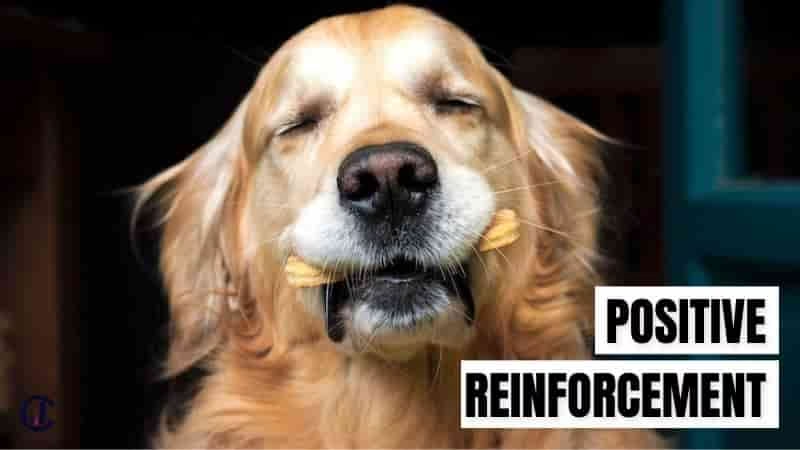
Positive Reinforcement Tips:
- Give tiny treats your dog likes. Highly desirable treats (such as tiny pieces of chicken, cheese, or liver) especially work well during dog training. A puppy will probably work for kibble, but if the pup isn’t motivated, bring out something even better.
- Timing is everything. If your dog immediately performs the behavior that is being rewarded, you have seconds to get that treat into their mouth. When using a clicker, click in that instant the dog performs the behavior successfully. Then, immediately give the treat. In this way, the dog knows exactly what behavior they got rewarded for. Any delay in treating may cause the dog to associate the treat with something else or with nothing.
- Praising or petting your dog can also be a reward. After your dog obeys a command, say “Yes!” or “Good boy!”, in the happiest voice you can manage, and reward it with a pat, ear rub, some playtime, or even good old-fashioned scratching behind the ears. For some dogs, these rewards are as valuable as food.
- Vary rewards to keep your dog interested. Sometimes give a treat, sometimes play with a favorite toy, sometimes give a long belly rub. If your dog expects variety, they’ll work to see what they get each time.
Correction Techniques (Gentle)
Corrections should be minimal, yet immediate. A firm “No” might suffice. However, never consider punishment: slapping, yelling, or shock collars are guaranteed to instill fear and cause suspicion in your dog. Instead of punishments, use negative punishments (remove things the dog enjoys) as light discipline; for example, if your dog jumps on you for attention, simply turn your back to him and ignore him until he calms down.
For instance:
- Reward with petting or treats as soon as the dog has all four paws on the ground.
- If the dog jumps, immediately turn your face away, step backward, and wait until the dog calms; reward it once all paws are down.
The dog will try to figure that jumping makes attention disappear, but sitting nicely means treats and attention.
Consistency over Patience
Every member of the household should apply every command and rule consistently. Dad lets the dog on the sofa, but Mom does not: how confusing for the dog! Always and without exception use the same word and gesture for a command. At the same time, adhere to a routine: feed the dog, take it for walks, and train it at about the same times so it can expect what is coming.
Stay patient as the behaviors are reinforced. The dog will never learn overnight. If a dog is struggling, break down the training into smaller steps and go slow. There will be days when you feel you’ve taken a few backward steps; that’s normal. Just keep the session short and positive and celebrate every little achievement. Consistency and patience will pay eventually.
Also Read: Separation Anxiety in Dogs: 5 Ways to Help Your Dog Feel Safe Alone
Foundational Commands
Here are the basic obedience commands every dog should know, their meaning, and how to train them. For impeccable training, kisses, and praises should be given immediately after release of the command. Make sure to practice salsa often.
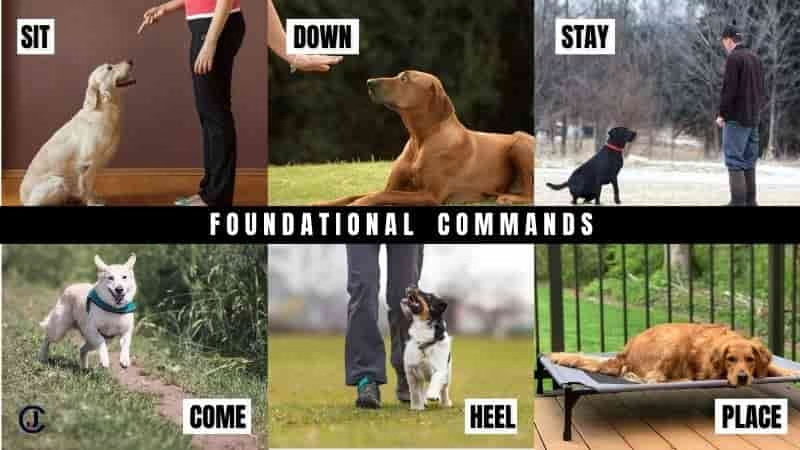
Sit
The dog lowers the hind end to the ground, when the back legs are bent and the front upright (most thus usually chest up), looking forward.
- Use: Calm greeting of people, polite art of waiting (e.g. at doorways/lower at meals), to start a lot of other commands.
- Training Steps: Your dog should now be standing. Put a tasty treat near your dog’s nose. Slowly move your hand with the treat upward but slightly back over the dog’s head. Normally the dog looks up and, consequently, lowers its rear end to the floor. At the very moment when the dog’s backside touches the floor, click your clicker or say, “Yes!” and treat it. While the dog is in the sit position, say the word “Sit.” Repeat the lure-and-reward a few times. Next, try it without having a treat in your hand, but make your hand motion anyway and click or treat after the dog sits. Then get rid of the hand motion, but keep rewarding occasionally so the dog will obey the verbal cue alone.
- Tip: Keep your palm flat on the chest or hold the treat at chest-level (do not have it out to the side) so the dog stays close. In case your dog hesitates, consider giving him or her the cue earlier and reward immediately. Remember also to use a release cue (e.g., “Okay!”) once they are free from it.
Down (Lie Down)
The dog is lying flat on his belly with elbows on the ground; the front legs can be extended out in front or folded back under the chest.
- Uses: Calming a dog, getting him to relax in public or at home, preventing him from jumping up in excitement.
- Training Steps: Get the dog to sit. Hold a treat and bring it close toward the dog’s nose. Slowly move the treat down toward the dog’s chest and along the floor away from the body. The dog will follow the treat and naturally slide down into the down position. The moment the dog is fully down, praise and reward. Do several short practice sessions. Eventually, when your dog reliably follows the lure, start saying “Down” as the dog begins to go down, and keep rewarding. To reinforce longer downs, occasionally feed a sequence of treats while the dog stays down.
- Tip: Keep the sessions fun and short. If the dog is struggling, only lure partially until it moves forward. Never ever force the dog down (especially great for senior dogs). Slowly lift your hand up; this will stretch the dog forward to get his treat.
Stay
The dog remains in place in the sit or down position until released by its handler. The dog must hold that position even though you walk away until told to move by some agreed enlightenment.
- Meaning: “Stay” means hold the position until I tell you you’re done. It is a much stronger command than a short form “wait” that lasts only a second or two.
- Training Steps: Teach the release word first. Use words such as “Okay,” “Free,” or “Break,” meaning the dog can now move. Have your dog sit or lie down. After one second, say the release drama word calmly, praise, and treat. Let the dog get up happily with more praise. Repeat the release word until your dog knows it can only move after hearing it. Then move on to the stay command: Name the dog to sit or lie down, hold your palm flat in front of you (as if it were a universal “stop” sign), and clearly say, “Stay.” Take one step backward, wait one second, return, and give a treat while saying, “Good stay”; then, say the release word (“Okay!”) to let the dog go. Even this begins to build duration. Every few seconds, increase the time before treating. Continue to do this slowly over many repetitions, gradually increasing the stay duration before the reward is given.
- Release Cue: Always end a stay with a release. Otherwise, the dog will not know when it is allowed to move. Common release words are “Okay,” “Free,” or “Done.” (Be careful not to select a word you often use in normal conversation.)
Building Duration
Reward once more when your dog will stay for about 10 seconds to keep the dog happy. Clicker users should click while the dog is staying, not when it moves.
- Distance and Distractions: If a dog can stay at your side for 10+ seconds, try taking a step back (treat); after a while, add a distraction (such as a clap or a toy) and practice again, always lowering your expectations with difficulty. For example, if you start walking around, reduce the stay time back to a few seconds until your dog gets used to it.
- If The Dog Breaks: If the dog breaks, never punish! Instead, calmly say “Ah-ah” or use a hand stop-sign to interrupt the dog’s action, then tag the dog back with a shorter stay. Usually, dogs break because the work they were asked to do is too hard (too long or too far).
- Real Life: Use stay when opening the front door (ask the dog to stay till you open the door) or when unloading the car (dog stays in the car seat till you give the signal).
Come (Recall)
The dog comes to you immediately when called, wherever it is.
- Uses: A true life-saver in emergencies, this command is used to call the dog to safety or to the handler’s side. This command is a must for off-leash training: freedom and emergencies.
- Training Steps: Start in a calm, low-distraction setting (e.g., indoors or fenced yard). Glasses or show a treat or toy. Step backward or squat with an enthusiastic “Name, Come!” As the dog starts approaching, praise with a treat in hand. The moment it reaches you, there should be heavy rewards with treats, praise, and maybe even some freedom to get back to playing or one more treat. Repeat this short recall several times. Once your dog runs to you reliably, slip in the cue just before releasing the dog from a sit. Always reward on coming.
- Make it a fun deal: Games such as “Catch Me” (where you run backward while calling the dog), “Find Me” (hide in another room and call), also try the “Hot Potato” game (family members take turns calling the dog between them). These will make the recall line fun and rewarding for your dog.
- Remember: Always reward the dog for coming, even if it took its time. Never use the recall to end a session or to go on a leash, as this immediately establishes recall as cue for “end of fun” and taints the dog (cue poisoning). Instead, have fun, reward, and then carry on with fun. Eventually, the dog will learn recalling great.
- Increasing difficulty: Begin gradually practicing recall from greater distances with increasing distractions. But keep very short sessions during initial training and super rewarding. When in practice, employ a long training leash so you can gently reel back if far apart wandering.
Heel (Walk at Side)
Dog walks calmly at your left or right side (traditionally left) without pulling on leash.
- Uses: Comfortable leash walks, passing another dog or person without lunging, obedience trials or rally, practice focus on you while in motion.
- Training Steps: Start indoors in an empty room or a quiet yard. Have treats ready to give to your dog. Walk several feet, then call the dog’s name and gesture to the side (e.g., point). When the dog comes to your side, mark (a click or say “Yes!”) and treat. Few repetitions: walk, call, reward at side. Thereafter, just walk and treat the dog when it comes to the side of its own accord. Gradually increase the time your dog is by your side before rewarding.
- During walks: Keep the dog interested by suddenly changing the pace, turning around, zig-zagging. These movements enforce the dog to “find” your side again and so will prevent the dog from being fixated on sniffing or distractions.
- Cue: Once the dog stays by the side consistently, attach the word “Heel” or “Side” just as the dog assumes its position and begin practicing walking, cueing “heel,” and rewarding by your side.
- Hand position: Keep the treat hand at chest height beside the body so the dog cannot jump up for food, keeping it close to its side. Always give the treat with the hand closest to your dog to avoid having them weave in front of you.
- If pulling: Stop walking when there is tension on the leash; keep the leash slack before continuing. Do not yank. Consider a front-clip harness or another mightier aid to discourage pulling. For now, reward the dog upon each realization of the pulled leash, and in the dog comes to sit and look at you, then proceed.
Place (Go to Mat/Bed)
The dog goes to a designated spot (like a mat or bed) and stays there until released.
- Uses: To get your dog out of your way (maybe dinner time or when guests arrive) or to keep it in a particular spot while you move about. It is like your “stay on your spot” command.
- Training Steps: Place a mat, a blanket, or a bed on the floor. Then lure your dog with treats onto the mat; as the dog plants its paws on the mat, mark (click or say “Yes!”) and treat, but immediately allow it to leave the mat. Repeat this until the dog moves onto the mat easily. Reward small steps towards or onto the mat to reinforce the behavior, especially if the dog tends to hesitate. Now decide whether the final behavior is going to be sitting or lying on the mat. Once the dog straightaway moves onto the mat, begin to add a cue word, such as “Place” or “Mat,” just as the dog steps on or sits.
- Add Distance and Duration: Take a few steps backward right after giving the “Place” cue, then return and reward. Keep doing so until you can take half a dozen steps away before treating. Meanwhile, practice giving cues from various locations inside the room (e.g., 1, 3, 5 feet away). Later, increase the duration the dog has to stay on the mat, starting from a couple of seconds to about a minute or more. Always use a release word so the dog is aware it’s free to leave the mat.
- Practical Use: This works great for door greetings: train the dog to go to its place (mat) as soon as the doorbell rings and reward it for staying there while the guests enter. You can put the dog back on the mat during meal prep so it stays calm.
Other Useful Commands:(Bonus tips beyond the required list)
- Off: Tells the dog to get off furniture or people. A quick “off” followed by removing treat/attention when jumping stops, and then praise, teaches them that four paws down earns rewards.
- Leave It/Drop It: Teaches the dog to ignore or release objects. Say “leave it” and cover an item; when the dog stops trying, reward it. Then say “take it” and give a trade treat. Helps when dog finds dangerous things to mouth. (Detailed training for these is similar with lures and trade strategies.)
- Wait: A quick pause command, e.g. at doors or before crossing streets, where the dog should hold position briefly until released. Often taught like a short “stay.”
Each of these commands should be introduced with patience and reward success. Avoid overloading the dog with too many commands at one time. Once your dog has mastered the commands “sit,” “stay,” “come,” others like “down,” “heel,” and “place” can be added gradually. It’s better to solidify each command in a calm environment before expecting it during a real-life situation.
Common Training Mistakes (and How to Avoid Them)
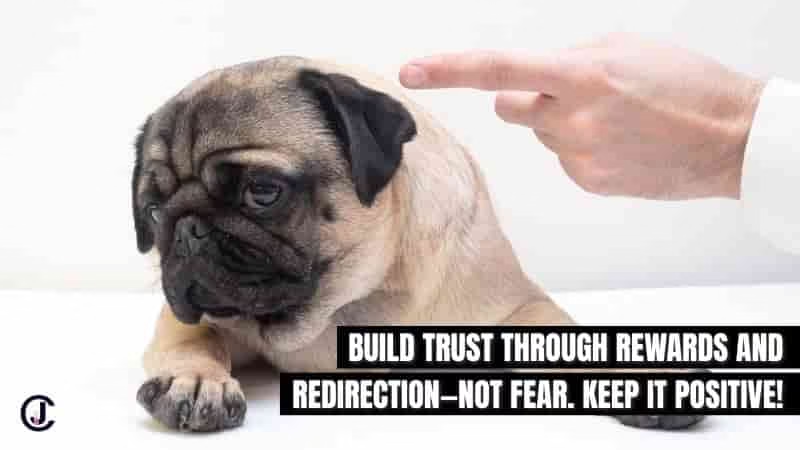
Even experienced pet owners can slip up. Here are common pitfalls and how to sidestep them:
- Repeating cues: Don’t nag your dog with the same word over and over (“Come, come, come!”). AKC notes that repeating a cue teaches the dog not to listen the first time. Instead, say your cue once and wait. If the dog doesn’t respond, do not say it again; try making it more obvious or practice more at home. Always call the dog’s name first (to get attention) before the command.
- Cue poisoning: Don’t always use a cue right before something unpleasant (e.g. don’t call your dog only when it’s time to go home from the dog park). If “come” always means the end of fun, the dog will avoid it. Always make at least some recalls fun – give a treat and then let it go play again. Likewise, if you bathe the dog or trim nails, don’t always call them; lure them in or put them on a leash as a different routine so “come” stays positive.
- Inconsistency: If you use a word, always use that same word. If one person says, “Sit,” and another person says, “Sit down,” for the same action, then the dog is going to be quite confused. The whole family must stick to the same rules. Also be consistent about which behaviors are allowed. For example, if the dog is not allowed on the couch, everyone must enforce that from day one. Mixed signals slow progress.
- Not rewarding enough: Some owners give a treat only once in a while or delay the reward. Dogs need frequent rewards during learning. Be generous with treats and praise, especially in the beginning. Use small treats that the dog will want. The Companion Animal Psychology blog points out that dogs will even run faster for better treats. If your dog isn’t enthusiastic, try something tastier or more interesting (cheese, chicken, or a really engaging toy). Also plan ahead so you can reward immediately. Keep treats in your pocket or bait bag so you don’t scramble for them after the dog has sat or stayed.
- Timing mistakes: Give the reward or click immediately when the dog does the right thing. If you’re slow, the dog may not link the treat to the behavior. However, don’t click or reward before the behavior is complete. (For example, don’t click for “sit” while the dog is still in motion before the bottom hits the floor.) Mark and treat as soon as the command is obeyed.
- Long sessions / impatience: Dogs get bored or distracted. Keep lessons short and sweet. Ten minutes is usually enough. If the dog loses focus, stop and try again later. Expecting instant perfection is unrealistic. If the dog did it once but forgets five minutes later, go back to easier steps. Learning happens in tiny steps and over many repetitions.
- Skipping generalization: Dogs may learn a command in your living room but fail to obey outside or with guests around. To avoid this, practice cues in different places and situations. AKC calls this “proofing” your dog. For example, once your dog sits at home, try asking it to sit on a walk or at the vet’s office. Start with low distractions and gradually make them stronger (add noise, other dogs, etc.).
- Neglecting daily practice: Don’t rely only on occasional training classes. Practice a few minutes every day. Integrate training into your routine: ask for a “sit” before feeding, a “down” in the morning, a “place” during TV time, etc. Even a brief review keeps skills sharp.
- Punishing mistakes: Never punish your dog during training (e.g. hitting it when it doesn’t obey). This creates fear, not learning. If your dog does something wrong, simply withhold the reward or calmly redirect to the desired behavior. Maintain a positive approach – make training a pleasant experience.
By being aware of these pitfalls, you’ll train more effectively and keep your dog happy. Remember, training is a learning process for both of you!
Real-Life Training Scenarios
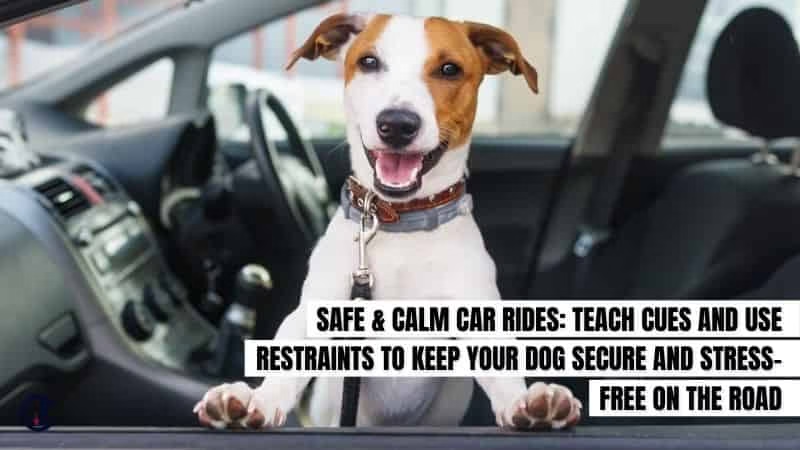
You should practice obedience in everyday situations, not just in quiet sessions. Here are common scenarios and how trained commands apply:
- Greeting Guests: When there is a knock at the door or the bell rings, have your dog sit or go to place immediately. For example, when someone presses the doorbell, the owner gives the cue “Place,” and the dog walks to its mat and stays. This prevents jumping and keeps guests safe. Once the dog is calmly settled (by praise or treat reward), then you can open the door.
- Leash Walking: Use “heel” or “leave it” to manage leash behavior. If your dog starts pulling, stop walking: wait for the leash to slack and the dog to come back, then start again. Praise or treat when it walks beside you instead of pulling. If squirrels or cars distract it, use the “watch me” cue (train the dog to look at you on cue) and reward its attention. Always carry treats during walks to reinforce good leash manners.
- Street Crossings and Doors: Teach “sit-stay” at curbs or doorways. When you approach a street or door, cue your dog to sit and hold “stay” until you give “Okay” to proceed. This prevents lunging into traffic or rushing out. You can practice at home by opening a door slowly – have the dog sit, then walk through first before releasing it.
- Car Rides: Ask your dog to wait or stay before jumping into a car. You might even train the dog to go into the car only after a cue (“Kennel” if you use a crate in the car, or “car” otherwise). This keeps boarding orderly. Also practice keeping your dog in one spot (seat or crate) with a harness or seatbelt attachment, rather than letting it move around the car.
- During Meals/Cooking: Have the dog “stay” or go to “place” while you prepare food, rather than begging at your feet. Reward it after you finish or give a post-meal treat.
- Play and Off-Leash Time: Use commands during play. Call your dog to “come” before throwing the ball again, rewarding it each time. Let your dog chase the ball, then call back; this teaches that recall leads to more fun. In the dog park, reinforce “sit,” “down,” or “stay” before letting it run off so it learns boundaries.
- Door Exits (Popular Trick): Teach your dog to sit or wait at every door. For instance, before going through the front door, say “sit” and hold until you have the leash or purse ready, then “okay.” This prevents the dog from barging out. Many owners tie a piece of tape on the floor or a small stopper as a visual cue for the dog’s sit spot by the door.
- Unexpected Situations: With every new situation, briefly apply a known behavior. For instance, the dog sees another dog at the other side of the street; use “sit” and “stay” commands until the dog passes the other. If guests leave suddenly, ask for a final “sit” or “place.” These real-life practices reinforce obedience in context.
Putting commands into daily situations makes them useful habits. Always reward calm, desired responses in these scenarios. Over time, your dog will learn that following commands during real events earns treats and praise.
Helpful Training Tools and Methods

Many trainings are achievable with treats and praises alone, but below are some of the implements and methods that could prove helpful:
- Clicker Training: A clicker is a small device that makes a distinct sound. It marks the exact moment a dog performs the desired behavior. If you use a clicker, click at the instant the dog obeys, then give a treat. (For example, click the moment its bottom hits the floor in a “sit,” then treat.) This helps the dog quickly understand what earned the reward. If you’re not comfortable with a clicker, simply use a consistent marker word like “Yes!” instead.
- Crate: Properly used, a crate (dog kennel) is a great training tool. It should be a safe and comfortable “den” for your dog. You can train your dog to commands like “crate” or “kennel.” A crate is best introduced by leaving the door wide open and enticing your dog to enter with treats or favorite toys. Feed your dog meals in the crate so it learns good things happen there. Then, once it enters easily, start closing the door for short periods, rewarding calm behavior. Never use the crate as punishment. A well-trained dog will see the crate as its personal space. (Crate training also helps with housebreaking, as dogs avoid soiling their sleeping area.)
- Leashes and Collars: Use a 6-foot leash and a flat collar or harness for most training. For sensitive dogs that pull a lot, a front-clip no-pull harness or head halter can help reduce pulling without pain. Always train walking separately (see “Heel”). Avoid choke or prong collars, as these can harm the dog.
- Treat Pouch or Pockets: To be ready to reward quickly, keep treats in a treat pouch or pocket on your hip. This way your hands are free, and treats are always within reach.
- Toys and Games: Some dogs are highly toy-motivated. Use a favorite toy as a reward by playing tug or fetch after a successful command, if the dog prefers that over treats. For example, ask for a “down,” and when the dog lies down, reward by a quick tug-of-war game.
- Targeting and Luring: You can use a target stick (or even your hand) to guide your dog into positions, similar to using a treat as a lure. This helps especially shy dogs. Over time, replace the target with the actual cue word.
- Training Classes: Services for guidance or socialization may include enrolling in a puppy or dog obedience course with a registered trainer. Being in the company of other dogs can help in socializing, and a trainer could also provide feedback on your technique.
Whatever tools you choose, always pair them with positive reinforcement. For instance, when crate-training, reward the dog each time it enters calmly. Use the leash/harness simply as an aid, not a punishment. And remember: the most powerful training tool is your consistency and your treats/praise.
Also Read: 7 Proven Techniques to Potty Train Your Puppy Fast (Even If You’re a First-Time Owner)
Daily Training Routine Checklist
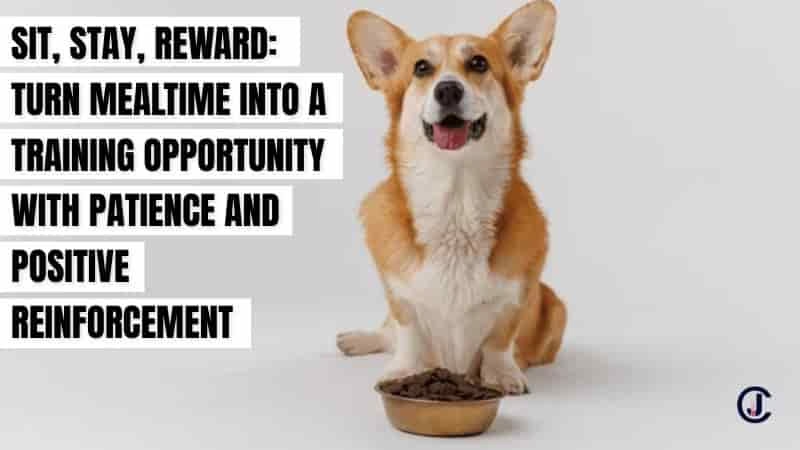
Having a simple routine can help you remember to train each day. Here’s an example checklist you might follow or adapt:
- Morning (before breakfast or walk):
- Sit/Stay: Ask the dog to sit and stay while you prep breakfast, then release and feed as reward.
- Recall: Short play in yard: call the dog from 3-5 feet away using “Come” and give treat/praise each time.
- Midday (after lunch or during break):
- Down: 5-minute session indoors: practice “down” from sit with treats.
- Leash Practice: Indoor or backyard loose-leash walking: reward for walking by your side without pulling.
- Afternoon/Evening (walk time):
- Heel: During one walk, focus on walking at heel for a few minutes, using treats to keep the dog by your side.
- Sit at intersections: Stop at street corners and ask for a sit-stay until you’re ready to cross.
- Leave It: If something tasty is on the sidewalk, practice “leave it” by covering it and treating when the dog ignores it.
- Evening (before bedtime):
- Place/Stay: At home, cue “place” and have dog lie on its bed or mat for a minute. Release with a treat.
- Come During Play: End the day with a little fun: while playing fetch or tug, occasionally call the dog to you for extra praise and letting it go back again.
- Throughout the Day:
- Use cues in everyday situations: e.g., ask for a sit before giving anything (meal, toy, leash, etc.), or ask for a down or place when you pick up your things. This reinforces that commands apply everywhere.
- Socialization practice: Let the dog meet new people and pets (safely) while it is calm on a “sit,” rewarding polite greetings.
Keep track of what commands your dog is good at and which need more work. Adjust the routine as needed (for instance, increase the difficulty gradually or change locations).
Final Thoughts
Obedience training, though requiring time and commitment, is probably one of the greatest gifts you can bestow on your dog. In a happy afterlife in all of one’s time, a trained dog is the safest and happiest, with whom one shares joyful moments without constant fret or frustration. You could sit back and enjoy the moment while watching your dog sit patiently before allowing a child to greet it or stand its ground if a car revs past and come when called. Training brings you together more than anything else: by working together and celebrating the achievements, your dog learns to trust and communicate with you.
Remember: patience and consistency are the keys. Everything depends on one dog’s pace of learning; some days it’s a leap forward and others it feels like two steps backward. Make sure to keep the sessions positive, short, and enjoyable. Use treats as rewards and show your dog affection with praises. Never use harsh punishment or baseless nagging. Over time, commitment, and efforts coupled with consistent positive reinforcement will make your dog obey its commands time after time.
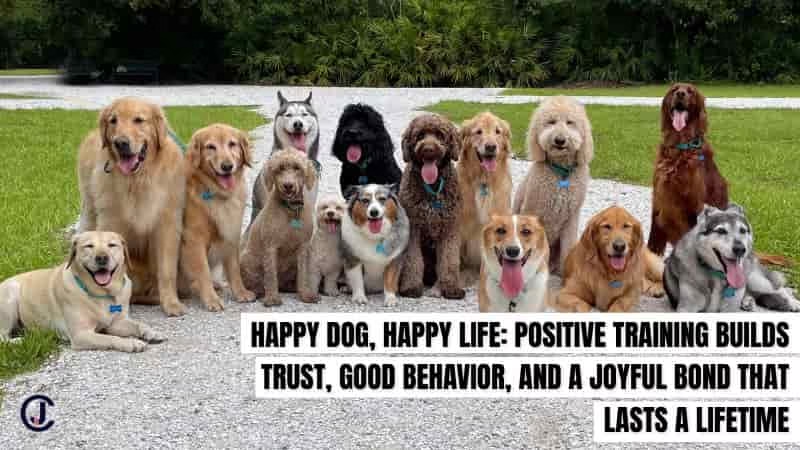
Ultimately, obedience training is an act of responsibility and affection. It ensures that a dog understands its world and their place in it, cutting down on fear and anxiety. It complements the dog by creating an easier living – pleasant walks, a smooth trip to the vet or groomer, and no chaos when house guests arrive. More importantly, it will strongly bind training with trust and respect.
Stay patient, be consistent, and enjoy every little success with your furry friend. The journey of training is a journey together, and in the end, you and your dog will have a lifetime of better understanding and happy memories. Ready to get started? Grab some treats, keep your tone upbeat, and enjoy the training journey—one paw at a time.
Good luck and happy training!


2 thoughts on “Proven Ways to Improve Basic Obedience and Dog Training Success in 2025”